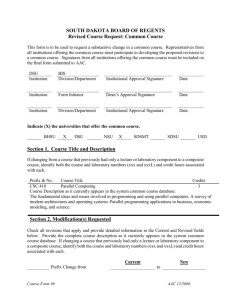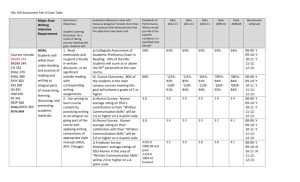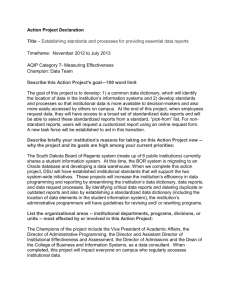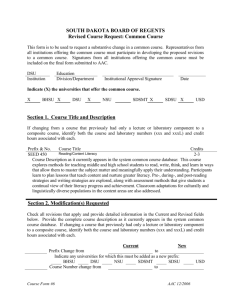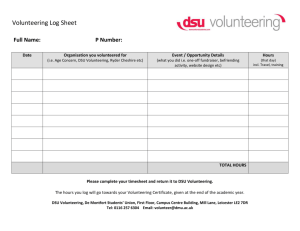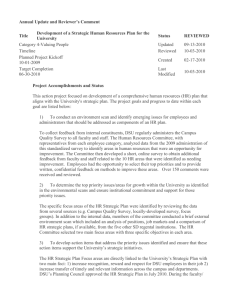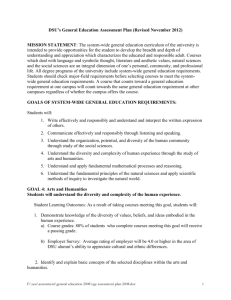2015 Institutional Core Theme Assessment Report
advertisement
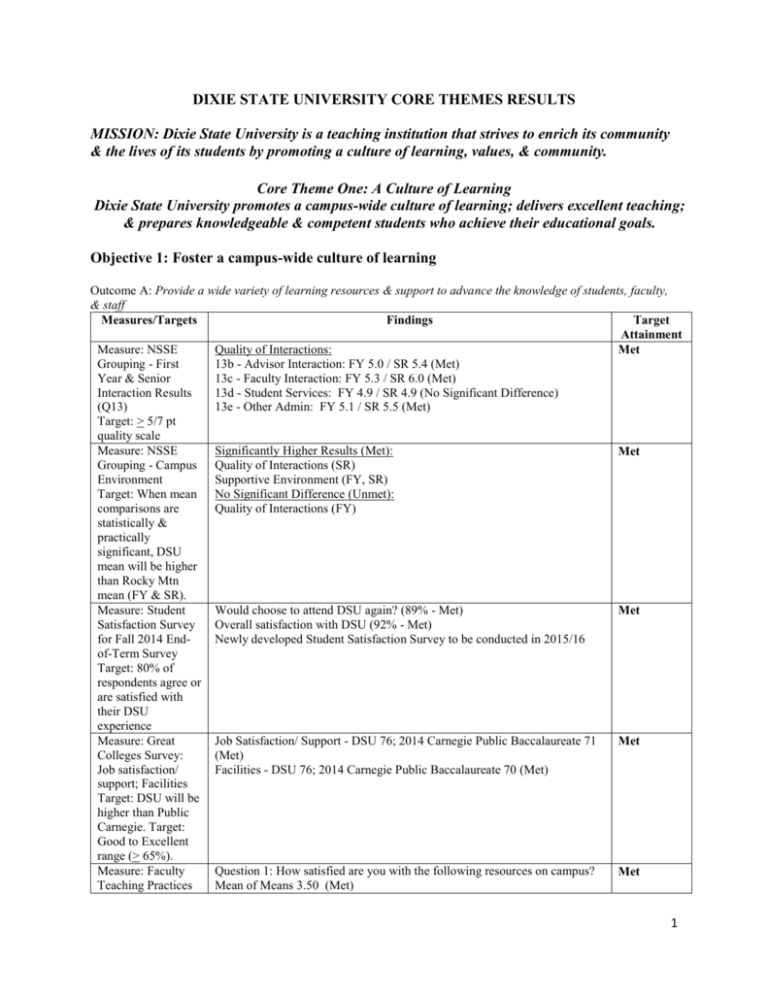
DIXIE STATE UNIVERSITY CORE THEMES RESULTS MISSION: Dixie State University is a teaching institution that strives to enrich its community & the lives of its students by promoting a culture of learning, values, & community. Core Theme One: A Culture of Learning Dixie State University promotes a campus-wide culture of learning; delivers excellent teaching; & prepares knowledgeable & competent students who achieve their educational goals. Objective 1: Foster a campus-wide culture of learning Outcome A: Provide a wide variety of learning resources & support to advance the knowledge of students, faculty, & staff Measures/Targets Findings Target Attainment Measure: NSSE Quality of Interactions: Met Grouping - First 13b - Advisor Interaction: FY 5.0 / SR 5.4 (Met) Year & Senior 13c - Faculty Interaction: FY 5.3 / SR 6.0 (Met) Interaction Results 13d - Student Services: FY 4.9 / SR 4.9 (No Significant Difference) (Q13) 13e - Other Admin: FY 5.1 / SR 5.5 (Met) Target: > 5/7 pt quality scale Measure: NSSE Significantly Higher Results (Met): Met Grouping - Campus Quality of Interactions (SR) Environment Supportive Environment (FY, SR) Target: When mean No Significant Difference (Unmet): comparisons are Quality of Interactions (FY) statistically & practically significant, DSU mean will be higher than Rocky Mtn mean (FY & SR). Measure: Student Would choose to attend DSU again? (89% - Met) Met Satisfaction Survey Overall satisfaction with DSU (92% - Met) for Fall 2014 EndNewly developed Student Satisfaction Survey to be conducted in 2015/16 of-Term Survey Target: 80% of respondents agree or are satisfied with their DSU experience Measure: Great Job Satisfaction/ Support - DSU 76; 2014 Carnegie Public Baccalaureate 71 Met Colleges Survey: (Met) Job satisfaction/ Facilities - DSU 76; 2014 Carnegie Public Baccalaureate 70 (Met) support; Facilities Target: DSU will be higher than Public Carnegie. Target: Good to Excellent range (> 65%). Measure: Faculty Question 1: How satisfied are you with the following resources on campus? Met Teaching Practices Mean of Means 3.50 (Met) 1 & Resources Survey (Q 1, 2, 8) Target: Mean will be > 3.0 (satisfied range on a 4 point scale). Office Space 3.46 Lab Space 3.88 Classroom Space 3.16 Library resources 3.68 Computer & Technical Resources 3.23 Clerical Support 3.62 Administrative support 3.31 Technical support 3.40 Teaching resources & support 3.36 Research support 3.54 Support for securing grants 3.83 Human resources support 3.17 Business services support 3.74 Custodial support 3.69 Facilities support 3.51 Food services 3.44 Bookstore 3.52 Health & wellness services 3.88 Campus police 3.59 New & continuing faculty orientation & training 3.08 Question 2: The institution provides adequate support & opportunity for me to advance my learning & development. Mean of 3.32 (Met) Question 8: The institution's technology meets my needs as a faculty member. Mean of 3.63 (Met) Recommendations: 1) Student Services will further investigate meaning of lower quality interaction scores for freshmen & seniors (13d) in the NSSE survey via focus groups. 2) The data used is from Fall 2014 End-of-Term Survey from student services. The survey should be replaced by Student Satisfaction Survey (Institutional survey). 3) The Faculty Teaching Practices & Resources Survey scale used a 4-point scale with NA as a fifth response option. It is recommended that a 5 point scale be used: Very dissatisfied, dissatisfied, neutral, satisfied, very satisfied, NA. 4) The Teaching & Learning Center should be involved in the administration & analysis of the Faculty Teaching Practices & Resources Survey. Objective Fulfillment: Based on the data provided for 1.1.A, the objective of providing a wide variety of learning resources & support to advance the knowledge of students, faculty, & staff, was met. Outcome B: Offer quality educational programs in response to need & demand Measures/Targets Findings Measure: Comparison of DSU program offerings to peer institution offerings Target: Programs considered meet the following requirements: 1) 1) Missing degrees in the following CIP Code Categories (Unmet): Social Sciences Physical Sciences (USHE approval 2015) Philosophy & Religious Studies Liberal Arts & Sciences General Studies & Humanities Public Administration & Social Service Professions Parks Recreation Leisure & Fitness Studies (USHE approval 2015) 2) Insufficient data from student surveys. (Unknown) Target Attainment Unmet 2 programs offered by >60% of peer institutions, 2) high student demand, & 3) high market demand. Measure: Regent review & approval process of new degrees Target: Target: 90% of new degrees proposed are approved. Measure: External evaluator report rating for 5 year program reviews Target: All program reviews will receive no less than “met academic & professional standards” (on a 3 point scale) by external reviewers. Measure: Regent review & approval process of 5 year program reviews Target: 100% programs will be approved. Measure: NSSE groupings – Academic Challenge; Learning with Peers; High Impact Practices Target: When mean comparisons are statistically & practically significant, DSU mean will be higher than Rocky Mtn mean (FY & SR). 3) Work groups researching the relationship between career demand & specific degree proposals. (Unknown) 7 new degree proposals – 5 approved (71%) , 2 pending approval 5 minors proposed – 5 approved (100%), 0 pending approval 9 new emphases proposed, 8 approved (89%), 1 pending approval 1 program endorsement proposed & approved (100%) Met For the 2014-15 AY, there were 5 academic programs under review. At this point in time, of the 5 programs, 3 have had an external evaluator, & all have met academic & professional standards based on their report. Met The 5 programs are still being processed, & have not been sent for approval by the Regents yet. The expected internal & external approval process should begin in September 2015. Unknown Academic Challenge & Learning with Peers Significantly Higher Results (Met): Higher-Order Learning (SR) Reflective & Integrative Learning (SR) Learning Strategies (SR) No Significant Difference (UnMet): Quantitative Reasoning (FY, SR) Collaborative Learning (SR) Discussions with Diverse Others (FY, SR) Higher-Order Learning (FY) Learning Strategies (FY) Significantly Lower Results (Unmet): Reflective & Integrative Learning (FY) Collaborative Learning (FY) Partially Met Recommendations: 1) Conduct feasibility study for missing CIP Code degrees. 2) May consider improving the new degree proposal process to be more efficient so that all programs proposed in one academic year get all the required approvals in that same year. The other option would be that 90% of new degrees proposed within an academic year are approved that same year. Also, may consider changing the outcome to be “Regent & NWCCU review & approval”. 3) Create a template & rubric for the program review external evaluators to use. 3 4) Move programs through the 5 year program review process more in line with the suggested timeline. Lag data for a year. 5) Include 3 year follow up reports for new degrees as part of the assessment process to evaluate academic & professional standards. 6) Programs should review their NSSE results, research the concepts, & provide faculty training. 7) Teaching & Learning Center will provide seminars & online resources on best practices related to NSSE engagement indicators. Objective Fulfillment: Based on the data provided for 1.1.B., the objective of offering quality educational programs in response to need & demand, was partially met. But, according to the number of recommendations is definitely an area that needs attention. Objective 2: Deliver excellent teaching in a student centered environment A) Faculty are qualified & strive to teach effectively Measures/Targets Target Attainment Partially Met Faculty with Terminal Degrees Terminal Degrees for DSU 70% 60% FT Fac w/ Terminal Degree 50% Axis Title Measure: Percent of faculty with terminal degrees in each school Target: Regents requires 60% of DSU faculty (FTE, Full-time & adjunct) have terminal degrees. Findings 40% PT Fac w/ Terminal Degree 30% 20% Total Fac w/ Terminal Degree 10% 0% 2011 2012 2013 2014 By Academic School 4 Measure: Credit hours taught by part-time faculty Target: Less than 40% of Student Credit Hours Generated by Parttime Instructors (Faculty Workload). Measure: Qualification of faculty teaching upper division courses. Target: 100% of upper division courses are taught by faculty with a terminal degree (or working toward) as required by regent policy. Measure: Faculty Teaching Practices & Resources Survey – items related to active learning pedagogical practices including trends on use of technology Target: Increase in use of technology & pedagogical techniques by 5% in 3 years. Percent of Institutional Student Credit Hours Generated by Part Time Instructors Regular Faculty Overload Part Time Adjunct and Wage Rated Instructors Teaching Assistants Fall 2013 4.20% 38.68% 0.00% Fall 2014 6.35% 34.23% 0.00% Total Percent of Institutional Student Credit Hours Generated by Part Time Instructors No current data available. 42.88% 40.58% Active learning pedagogical practices Baseline (Q3, Q4 & Q6): Met Unknown Unknown (Baseline data) 5 Q4 Rank order the five teaching practices from the dropdown list that you use most frequently (1 being most frequent) 6 7 1 Annual Teaching and Learning Conference – 150 Unknown Measure: Number Lunch & Learn Sessions – 241 (Baseline of Faculty serviced CTL Workshops – 106 data) by Center for Conducted Individual and Departmental Consultations – 103 Teaching and Total Faculty and Staff participation at sponsored events: 600 Learning Target: Faculty use of the Center for Teaching and Learning will increase by 5% in 3 years. Recommendations: 1) While maintain the number of part-time faculty with terminal degrees, focus on percentage of full-time faculty with terminal degrees. 2) Special attention should be paid by Health Sciences and Education to monitor need and requirements for terminal degrees. 3) Continue to monitor percentage of credit hours generated by part-time instructors. 4) Change active learning indicator benchmarks to align with the Teaching Practices & Resources Survey questions. For example, survey question 7 asks how frequently do you incorporate the following forms of technology, and the response options range from Never to Very Often. Based on the latter, cannot determine the increase in usage of 5% in 3 years. 5) Baseline was set at 600 participants at CTL events. Recommend revising the measure to: Number of participants to events organized by the Center for Teaching and Learning. 6) If faculty are not to teach overload, then more full-time faculty must be hired in order to not exceed optimal adjunct teaching percentage. Objective Fulfillment: Based on the data provided above for 1.2.A, the objective of meeting faculty qualifications was partially met. The limit for the portion of instruction by part-time faculty was met. Data for faculty striving to teach effectively is baseline and will be monitored by the Center for Teaching and Learning. st B) Students engage in active learning in the classroom Measures/Targets Measure: Student Pedagogy Survey – items related to active learning practices Target: 75% of students indicated faculty use 3 or more active learning techniques some of the time (or more). Measure: NSSE Grouping – High Impact Practices Target: When mean comparisons are statistically & practically significant, DSU mean will be higher Findings Survey to be conducted in 2015/16. High Impact Practices Significantly Higher Results (Met): Service Learning (FY, SR) Research with Faculty (FY, SR) Learning Community (SR) Culminating Senior Experience (SR) No Significant Difference (Unmet): Internship or Field Exp. (SR)Student Significantly Lower Results (Unmet): Target Attainment Unknown First Year Partially Met Seniors Met 8 than Rocky Mtn Learning Community (FY) mean (FY & SR). Study Abroad (SR) Recommendations: 1) Increase emphasis on junior & senior students participating in internships & practical field experience. Deans identify areas in their divisions where they should be utilized to the students’ career advantage. 2) Have the Center for Teaching & Learning research learning communities & study abroad best practices & make recommend to Academic VP & Deans regarding their application at DSU. 3) The Center for Teaching & Learning should continue to present seminars on a variety of high impact learning practices. Objective Fulfillment: Based on the NSSE data for 1.2.B. Students engage in active learning in the classroom, shoe need for an increase in number of students participating in High Impact Learning Practices, especially at the freshman level. C) The institution maintains an atmosphere characterized by strong relationships & positive interpersonal interactions between faculty & students Measures/Targets Findings Target Attainment Measure: Student to Data from the common data set. Met faculty ratio (IPEDS) Target: Student to faculty ratio is 25:1 or lower. Measure: Met Percentage of courses by student class size range (Common Data Set) Target: More than 65% of class sections have less than 30 students. Measure: NSSE Significantly Higher Results (Met): Met grouping – Student-Faculty Interactions (SR) Experience with Effective Teaching Practices (FY & SR) Faculty No Significant Difference (Unmet): Target: DSU mean Student-Faculty Interactions (FY) will be higher than Rocky Mtn mean (FY & SR). Measure: Student Survey to be conducted in 2015/16 Unknown Satisfaction Survey (Faculty Section – Interpersonal questions) Target: 60% will agree/strongly agree on a 5 point satisfaction scale. Recommendations: 1) It is time to reconsider faculty to student ratio and class size targets. 2) Increase emphasis on faculty interactions with freshman. At most vulnerable stage of higher education, faculty should more fully engage freshman. 9 3) Divisions should review NSSE results, research the indicators, and respond accordingly. Objective Fulfillment: Based on the data for 1.2.C regarding the target percentage of employees indicating that the institution maintains an atmosphere characterized by strong relationships & positive interpersonal interactions between faculty & students, is met. With change to university status and growth, the institution needs to reconsider targets and respond to growth and develop challenges. Objective 3: Develop students’ knowledge & skills, enabling them to succeed in a changing & competitive world A) Students develop & master relevant knowledge & skills Measures/Targets Findings Measure: GE learning outcome attainment, based on AAC&U’s VALUE rubrics (4 point scale) Target: 70% of students will perform at a 2-3 (milestones), some competency. The General Education Assessment Committee is responsible for assessing student competency of the General Education Outcomes. During the 2013-14 academic years, two skills were assessed: (a) written communication & (b) critical thinking. Written Communication: For written communication, a random selection of student work from the ENGL 2010 course was assessed using the AAC&U VALUE rubric for Written Communication. The ENGL 2010 course was chosen because it is a course all DSU students are required to take. Target Attainment Met The results indicate that target was achieved from the written communication assessment. Overall, students scored between 2.6 & 2.93 on the five criteria of the rubric, with the lowest average score when providing sources & evidence (2.6 on a 4-point scale). Critical Thinking: For critical thinking, a total of 95 student artifacts were randomly selected from all sections of the following courses: (a) English 1010, (b) Mathematics 1210, (c) Art 1010, (d) Humanities 1010, (e) Chemistry 1210/1215, & (f) Physics 1010. The intent was to sample artifacts from a selection of GE courses that represented the student enrollment patterns. A form of the AAC&U VALUE rubric for Critical Thinking was used to assess the students’ work. 10 Measure: Percent of programs meeting their PLO benchmarks based on rubric ratings (3point scale: 1) not met, 2) met, 3) exceeded) Threshold: 75% of programs will submit completed Assessment Forms. Target: Of those responding 70% of programs/outcomes will have at least met their PLO benchmarks. Since each content area had raters that specialized in their specific discipline, it was not possible to analyze the data simultaneously. Therefore, the results are presented on different linear scales, & summarized separately. The results indicate that target was partially met in all discipline areas for most of the five criteria on the rubric. Students scored lowest when: (a) explaining the issue in ART 1010, (b) providing evidence in ENGL 1010, CHEM 1215, & PHYS 1010, (c) analyzing assumptions in ENGL 1010, (d) defending their position in MATH 1210 & HUM 1010, & (e) drawing conclusions in HUM 1010. The fact that the data could not be aggregated poses some difficulty for the GE committee when evaluating Critical Thinking for the GE program as a whole, & setting benchmarks for future assessment cycles. These findings were presented to stakeholders such as the General Education committee, the Deans, the Vice President of Academics, & the English faculty. Over 83% of the programs, according to assigned workspace, had an assessment plan with findings & action plan that was shared or reviewed. Plan Findings Action Plan not started 4 11 9 shared 16 14 16 reviewed 26 21 21 total 46 46 46 One hundred twenty three measures were identified for this academic year. Of those reviewed, 92 measures reported findings. Of the 92, results show 20% (18) did not meet their target, 38% (35) met their target & 20% (18) exceeded their target. Threshold: Met Target: UnMet 11 Recommendations: 1) General Education - Written Communication: According to AAC&U, a score of 2 or 3 represent intermediate milestones that indicate that students are moving toward more complex & sophisticated demonstrations of learning. Therefore, an average score between 2 & 3 would be an acceptable level of achievement for students in their general education program. A limitation to the findings is that the sample size was halved due to the fact that half of the scores were not as reliable even though the raters were calibrated. More attention will be placed on obtaining reliable scores in the next assessment cycle. 2) General Education – Critical Thinking: The main recommendations for this assessment are (a) increase the sampling across more GE courses for each outcome assessed, & (b) to try to standardize the use of the rubric so that data can be aggregated. 3) For academic program assessment, adjust threshold & target to match Taskstream reports. 4) For academic program assessment, change threshold language to “75% of the programs, according to assigned workspace, will have an assessment plan with findings & action plan shared or reviewed”. 5) For academic program assessment, change language to “70% of measures identified with findings will have at least met their target”. 6) Reduce the number of unspecified measures. 7) Total budget request amount affiliated with action plans aligned to findings is $200,000. The resources requested should be reviewed by the respective Deans to evaluate how providing the resources can help academic programs better meet their targets. Outcome Fulfillment: Based on the data provided for 1.3.A. the objective that students develop & master relevant knowledge & skills was partially met. The critical issues are process improvement, increasing the number programs reporting findings, & dean involvement. The target for programs meeting their learning outcome benchmarks was unmet. It is critical that faculty use this data to improve their programs and, thereby, the success of students in accomplishing their learning outcomes. 12 Objective 4: Support student achievement of their educational goals A) Support students in the transition to, progress in & attainment of their chosen major Measures/Targets Findings Measure: Retention rate (2012: 58.3% for 4 year public institutions with open selectivity reported by ACT) Target: Meet national average retention rates. Measure: Student satisfaction survey (questions 94-99, General comments) Target: 80% of students will agree or strongly agree with the statement. Measure: NSSE Grouping – Quality of Interactions Target: When mean comparisons are statistically & practically significant, DSU mean will be higher than Rocky Mtn mean (FY & SR). Measure: Graduating student survey (questions 83-88 educational goals, Overall) Target: 80% of students will agree Target Attainment Partially Met Survey to be conducted in 2015/16 Unknown Q3: Student-Faculty Interactions (SR) (Met) Student-Faculty Interactions (FY) (No significant Difference - Unmet) Quality Interactions (FY) 13a – Students: FY 5.5 / SR 6.0 (Met) 13b - Advisor Interaction: FY 5.0 / SR 5.4 (Met) 13c - Faculty Interaction: FY 5.3 / SR 6.0 (Met) 13d - Student Services: FY 4.9 / SR 4.9 (No significant Difference - Unmet) 13e - Other Admin: FY 5.1 / SR 5.5 (Met) Met, except for First Year StudentFaculty Interactions & Student Services Interactions Survey piloted Spring 2015. Will be revised & conducted Fall 2015. Unknown 13 or strongly agree with the statements. Measure: Nonreturning student survey Target: Will be used as a needs assessment. Results conducted in Spring 2014 of Fall 2012 Cohorts students who did not return in the Fall 2013. N/A Measure: Degrees awarded Target: Degrees awarded trend upward by degree type. Unmet Measure: Graduation rate (2012 is 27.2% for 4 year public institutions with open selectivity reported by ACT) Target: Meet national average graduation rates. Unmet Measure: Time to degree from Complete College America (2008: 55 months, reported by 2012-2013 Full-time, Bachelor-Degree seeking from CCA is 5.84 years = 70.08 months. Unmet 14 the National Center for Education Stats) Target: Meet national median time to degree. Recommendations: 1) Investigate why retention rate fell in 2013. Utilize best practices to improve retention. 2) Concerted effort is needed to engage freshman, in particular, in positive and meaningful interactions with faculty, student services and each other inside and outside the classroom. 3) Faculty need to engage freshman in activities and discussions other than classwork. 4) Divisions should review NSSE results, research the indicators, and respond accordingly. 5) Concerted effort is needed to look at graduation rate and time to completion data to implement changes and create positive results. Objective Fulfillment: 1.4.A is an area of strategic importance to the institution and the majority of the indicator targets are unmet or unknown. Concerted efforts need to be made to improve quality of interactions, and to increase number of degrees awarded, retention, graduation and time to degree rates. Core Theme Two: A Culture of Values Dixie State University invests in a culture of values which include service, citizenship, diversity, ethics, & collaboration. Objective 1: Engage students & employees in service & citizenship activities that enhance their Dixie State University experience A) Students are engaged in service & citizenship activities that enhance their Dixie experiences Measures/Targets Findings Measure: NSSE Q12 (service learning) Q15e (community service or volunteer work) Target: When mean comparisons are statistically & practically significant, DSU mean will be higher than Rocky Mtn mean (FY & SR). Measure: NSSE Question: Q17j (Being an informed & active citizen) Target: When mean comparisons are statistically & practically significant, DSU mean will be higher Q 12 - # of courses that include a community-based project (FY/SR): DSU: FY 1.6 (Insignificant Difference - Unmet) / SR 1.9 (Met) Rocky Mountain: 1.6 / 1.7 Target Attainment Met Q15e - # of hours doing community service or volunteer work (FY/SR): DSU: FY 3.2 (Met) / SR 3.9 (Met) Rocky Mountain: 2.4 / 3.3 Q17j: Being an informed an active citizen DSU: FY 2.4 (Unmet) / SR 2.6 (Met) Rocky Mountain: 2.6 / 2.5 (FY & SR) Partially Met 15 that Rocky Mtn mean (FY & SR). Recommendations: 1) Divisions should review NSSE results, research the concepts, and provide faculty training. 2) The Teaching & Learning Center should provide seminars & online resources regarding community-based learning projects. 3) Increase student government outreach to freshmen students on voting and informed citizenship. Outcome Fulfillment: The target for 2.1.A, Students are engaged in service & citizenship activities that enhance their Dixie experiences, was ‘met’, except for First Year students’ level of involvement in community-based projects & community service & volunteer work. Engaging students early in their high education experience in developing community mindedness is important, therefore, DSU needs to provide opportunities for these activities in the first semesters at college. B) Faculty & Staff engage in volunteer service & citizenship activities that benefit the campus & community Measures/Targets Findings Target Attainment Measure: Employee In a 2015 survey, 86.5% of Faculty, 63.9% of Staff and 93.1% of Admin Unknown participation in participated in at least 1 professionally related service. (Baseline professional service data) (survey) Target: 70 % of faculty, 50% of staff and 70% of Administration participate in professionally related service. Measure: Employee In a 2015 survey, 93.6% of Faculty, 86.5% of Staff and 100% of Admin Unknown participation in participated in at least 1 citizenship activity. (Baseline citizenship activities data) Target: 75% of faculty, staff and Administration participate in citizenship activity. Recommendations: 1) Create a measure of intuitional encouragement of employee participation in service, add survey question. Outcome Fulfillment: The status for 2.1.B is Unknown. Objective 2: Promote an environment of respectful, responsible, & ethical behavior A) Campus culture creates an expectation of responsible, respectful, & ethical behavior. Measures/Targets Findings Measure: Sampling of syllabi for inclusion of statement Target: 100% syllabi compliance, as reported by No data yet available. Target Attainment Unknown 16 school deans to PAIR Measure: Student policies include a code of conduct (student website handbook) Target: student policies, comparable to peer institutions & reflecting DSU values. Measure: Student Satisfaction Survey: Climate Section Target: The Student Satisfaction Survey Climate Section will have a mean of >3.0 on a 5 point agreement scale. Measure: NSEE Q8 (Discussions with people of different backgrounds) Q14d,Q14i, Q17g (Personal Code of Values), Q17h (Understand People) Target: DSU mean will be higher than Rocky Mtn mean (FY & SR). The DSU Student Website includes student rights and their code of conduct, Student Rights and Responsibilities code, Policy 5:33: http://dixie.edu/humanres/policy/sec5/533.html Met New Survey to be conducted in 2015/16 Unknown Discussions with people from following groups (FY/SR): 8a. Different race or ethnicity DSU: FY 2.9 (Unmet) / SR 2.8 (Unmet) Rocky Mountain: 2.9 / 2.9 8b. Different economic background DSU: FY 2.8 (Unmet) / SR 3.0 (Unmet) Rocky Mountain: 3.0 / 3.0 8c. Different religious beliefs DSU: FY 2.9 (Unmet) / SR 3.1 (Met) Rocky Mountain: 3.0 / 3.0 8d. Different political views DSU: FY 2.9 (Unmet) / SR 3.1 (Met) Rocky Mountain: 3.0 / 3.0 Partially Met Q14d DSU emphasizes contact with students of different backgrounds DSU: FY 2.6 (Met) / SR 2.6 (Met) Rocky Mountain: 2.5 / 3.4 Q14i DSU emphasizes attending events that address important social, economic & political issues DSU: FY 2.5 (No Sig, Diff) / SR 2.2 (Unmet) Rocky Mountain: 2.5 / 2.4 Q17g - DSU experience helped develop or clarify a personal code of values and ethics: FY/SR DSU: FY 2.5 (Unmet) / SR 2.7 (Met) Rocky Mountain: 2.5 / 2.5 Q17h - DSU experience helped understanding people of other backgrounds. FY/ SR DSU: FY 2.5 (Unmet) / SR 2.7 (Met) Rocky Mountain: 2.5 / 2.6 DSU emphasizes contact with students of different backgrounds, but provides limited opportunity because of homogenous on & off-campus community. 17 Measure: Great Fairness – DSU 53; 2014 Carnegie Public Baccalaureate 56 (Unmet) Unmet Colleges to Work Respect & Appreciation – DSU 53; 2014 Carnegie Public Baccalaureate 59 For Survey: (Unmet) Fairness; Respect & Supervisors/Department Chairs – DSU 71, 2014 Carnegie Public Appreciation; Baccalaureate 71 (Partially Met) Supervisor/Departm ent Chairs Threshold: DSU will be higher than Public Carnegie comparison. Target: Good to Excellent range (> 65%). Recommendations: 1) Provide greater opportunity for students to interact with students & others of different backgrounds. Recruit diverse students, faculty & staff. This is particularly important for first year students. 2) Provide greater opportunity for students in all courses, but especially First Year students, to develop & clarify their personal code of values & ethics. The Center for Teaching & Learning should provide seminars on this topic, particularly in GE courses commonly taken in first year. Objective Fulfillment: That objective 2.2.A is only partially met is of concern. Efforts to fully promote an environment of respectful, responsible and ethical behavior are of critical importance. Objective 3: Foster a climate of support & collaboration A) Campus culture fosters a spirit of camaraderie & pride in DSU mission Measures/Targets Findings Measure: Great Colleges to Work For Survey: Professional Development; Pride; Collaboration; Senior Leadership; Faculty, Administration & Staff Relations Threshold: DSU will be higher than Public Carnegie comparison. Target: Good to Excellent range (> 65%). Great Colleges to Work For Survey: Job satisfaction & Support; Communication Threshold: DSU will be higher than Professional Development – DSU 67; 2014 Carnegie Public Baccalaureate 66 (Met) Pride – DSU 79; 2014 Carnegie Public Baccalaureate 73 (Met) Collaboration – DSU 59, 2014 Carnegie Public Baccalaureate 58 (Partially Met) Senior Leadership – DSU 58, 2014 Carnegie Public Baccalaureate 56 (Partially Met) Faculty, Administration & Staff Relations – DSU 51, 2014 Carnegie Public Baccalaureate 52 (Unmet) Job satisfaction & Support – DSU 76; 2014 Carnegie Public Baccalaureate 71 (Met) Communication – DSU 52; 2014 Carnegie Public Baccalaureate 54 (Unmet) Target Attainment Partially Met Partially Met 18 Public Carnegie comparison. Target: Good to Excellent range (> 65%). Recommendations: 1) Conduct focus groups and based on results and initiate programs to improve Collaboration; Senior Leadership; Faculty, Administration & Staff Relations; and Communication across campus. Objective Fulfillment: That objective 2.3.A is only partially met is of concern. Efforts to fully foster a climate of support and collaboration are of critical importance. Core Theme Three: A Culture of Community Dixie State University builds & maintains strong relationships between students, faculty, staff & community to foster economic growth & a continuum of educational, cultural & recreational enrichment. Objective 1: Enrich educational exchanges between community, businesses, & the university by providing effective high quality opportunities & partnerships A) Successful educational exchanges with the community Measures/Targets Findings Measure: Trends in participation; Number of participants Target: Total participation by community in educational exchanges will grow 5% over 3 years. Measure: Number & types of exchanges Target: Number & types of exchanges will grow 5% over 3 years. Measure: Customized participant satisfaction survey by program Target: 75% of participants are Of the 36 Educational Programs and Exchanges with the community, 10 programs provided counts totaling 8,441 participants. 36 Educational Programs and Exchanges offered with the community: Community Education – After School Programs Community Education Channel (CEC) Colorado Plateau Institution Computer Camps Concurrent Enrollment Conferences and Workshops Preschool Dental Clinic Road Scholar Of the 36 Educational Programs and Exchanges with the community, only 1 program (Youth Conferences and the ACT conference - 261) completed surveys. Target Attainment Unknown (Baseline data) Unknown (Baseline data) Unknown (Baseline data) 19 satisfied with the programs. Recommendations: 1) A philosophy and definition of educational exchange valued by the institution need to be determined. 2) There is a need to collect more than participation rates; where appropriate, quality of service also needs to be assessed. 3) Reviews of need, interest, and quality of educational exchanges are important to make strategic determination of offerings. Objective Fulfillment: The status for 3.1.A is unknown. Assessment of not only participation, but quality, want and need are critical aspects of strategically assessing programs. B) Successful educational exchanges with businesses Measures/Targets Measure: Trends in participation; Number of participants Target: Participation by businesses in educational exchanges will grow 5% over 3 years. Measure: Number & types of exchanges Target: Number & types of exchanges will grow 5% over 3 years. Findings Of the 30 Educational Programs and Exchanges with business, 14 programs provided counts totaling 1,526 participants. 30 Educational Programs and Exchanges offered with business: Career Center CIT Job Board Clinical Rotations Cooperative Education Internships Practicums Preceptorships Student Teaching Volunteer Tax Program (VITA) Castle Rock Music Camp Ragin Red Outreach Workshop Of the 30 Educational Programs and Exchanges with business, 9 programs (368, mostly graduation surveys) completed surveys. There is not a standardized participant satisfaction survey or set of survey questions that must be included. Target Attainment Unknown (Baseline data) Unknown (Baseline data) Measure: Unknown Customized (Baseline participant data) satisfaction survey by program Target: 75% of participants are satisfied with the programs. Recommendations: 1) Define educational exchanges with businesses, determine who is participating, and how to gather data on quantity and quality of exchanges. Objective Fulfillment: The status for 3.1.B is unknown. Assessment of not only participation, but quality, want and need are critical aspects of strategically assessing programs. 20 Objective 2: Engage the campus & community by providing a variety of quality cultural, athletic, & social programs & events. A) Campus & community are engaged in cultural programs & events Measures/Targets Findings Measure: Number of participants Target: Total participation by community in cultural programs & events will grow 5% over 3 years. Measure: Number & types of programs & events Target: Number & types of program & events will grow 5% over 3 years. 2012-2013 Of the 24 cultural events, 22 events provided counts totaling 37,157 participants. In 2012-2013: 24 cultural events offered: Dance concert DOCUTAH Art Shows Celebrity Concert Series Open Mic Nights Native American Youth Conference Tonaquint Intermediate Multicultural Students Tour New survey to be piloted in 2016/2017. Target Attainment Unknown (Baseline data) Unknown (Baseline data) Measure: Unknown Community interest (Baseline survey data) Target: Target: 50% of new programs & events will be in response to community interest. Measure: No survey data. Participant satisfaction survey Target: 75% of participants are satisfied with the programs. Recommendations: 1) There is a need to collect more than participation rates; where appropriate, quality of service also needs to be assessed. 2) Reviews of need, interest, and quality of educational exchanges are important. Objective Fulfillment: The status for 3.2.A is unknown. Assessment of not only participation, but quality, want and need are critical aspects of strategically assessing programs. B) Campus & community are engaged in athletic & social events Measures/Targets Findings Measure: Number of participants Target: Total participation by community in 2012-2013 Of the 117 social and 203 athletic events, 302 events (107 social and 295 athletic events) provided counts totaling 143,401 (54,773 in social and 88,628 in athletic events). Target Attainment Unknown (Baseline data) 21 athletic & social events will grow 5% over 3 years. Measure: Number & types of athletic & social events Target: Number & types of events will grow/change 5% over 3 years. In 2012-2013: 117 social and 203 athletic events offered: Holland Dedication Grad Fair Tailgate events Men’s Basketball Baseball Football Intramural Activities College Fair Financial Aid Nights Week of Welcome Carnival Homecoming Parade Macklemore Concert New survey to be conducted in 2016 Unknown (Baseline data) Measure: Unknown Community interest (Baseline survey data) Target: Target: 50% of new social events will be in response to community interest. Measure: No survey data. Unknown Participant (Baseline satisfaction survey data) Target: 75% of participants are satisfied with the events. Recommendations: 1) There is a need to collect more than participation rates; where appropriate, quality of service also needs to be assessed. 2) Reviews of need, interest, and quality of educational exchanges are important. Objective Fulfillment: The status for 3.2.B is unknown. . Assessment of not only participation, but quality, want and need are critical aspects of strategically assessing programs. Objective 3: Encourage economic development by assisting & supporting individuals, businesses & community organizations to nurture the growth of the regional economy DSU is a primary partner in nurturing the growth of the regional economy Measures/Targets Findings Measure: Business Resource Center (BRC) reports: numbers of engagements & services to companies (BRC) provided annually. Findings: For the second half of 2014 and the first half of 2015, the Business Resource Center BRC has had a new director & service numbers were not maintained. A new director has committed to maintaining service files. Following is an example of BRC programs offered & their service numbers: Target Attainment Unknown for 2014-15 Met for 2013-14 22 Target: Increase BRC’s number of services & engagements provided by 10% annually. Measure: Small Business Development Center (SBDC) number of longterm clients, business starts & capital infusion Target: Increase St. George SBDC numbers annually & meet targets set by state SBDC Measure: Small Business Development Center (SBDC) customer satisfaction ratings, including GOED Chrisman statewide survey (BRC) The Business Resource Center (BRC) is a consortium of business support programs. The programs offered by the St. George BRC are: SBDC - Small Business Development Center: a Utah Office of Government of Economic Development (GOED) contract with the national Small Business Administration (SBA). USTAR – Utah Science & Technology Initiative (Utah government grant) PTAC - Procurement Technical Assistance Center (GOED funded). USTAR is being restructured in 2015, uncertain of impact. SCORE – Volunteer business people helping small business people succeed Site Select Plus – Washington County Economic Development private & public partnership Increase numbers annually (Met) & meet targets set by state SBDC (Met). Findings: Long-term clients: 133 (105% Target) (Met) Business starts: 38 (181% Target) (Met) Capital infusion: $9,990,700 (151% Target) (Met) SBDC participants are satisfied with service Findings: Satisfaction data for 2014 was 100% (Met), for 2013 satisfaction ratings were 95% (Met), for 2012 were 83% (Met). Ratings exceeded target. & show improvement over time. Met Met 23 Target: 80% of SBDC participants are satisfied with service (Mean of at least 4 on 5 point satisfaction scale). Measure: St. George SBDC scorecard meets or exceeds all goals and actual numbers compared to Met SBDC fulfills its other SBDC’s in Utah. mission & Findings: St. George’s SBDC exceeded all its goals & the actual numbers of performance other Utah SBDC’s except for capital infusion of Logan. (Met) measures Target: SBDC scorecard meets or exceeds all goals & actual numbers compared to other SBDC’s in Utah. Recommendations: 1) Maintain Business Resource Center Service numbers & records & trend over time. 2) All BRC programs maintain customer satisfaction information and respond to data with strategic planning. Objective Fulfillment: Objective 3.3.A, DSU is a primary partner, through the BRC programs, in nurturing the growth of the regional economy, has been substantially met. The BRC is known throughout Utah as providing superior business support services. It is, however, important that the BRC maintain and assess customer need & satisfaction, as well as numbers of services & participants. 24
